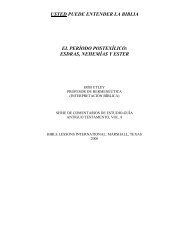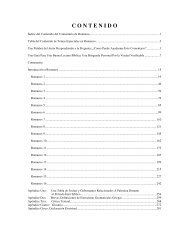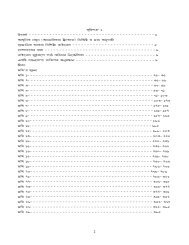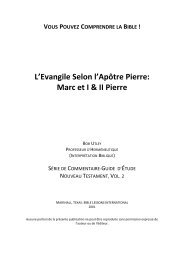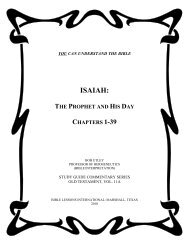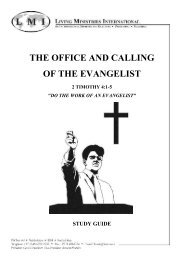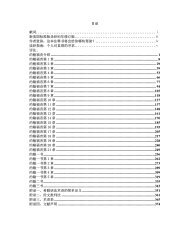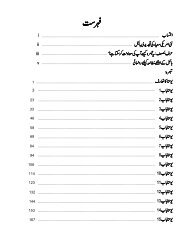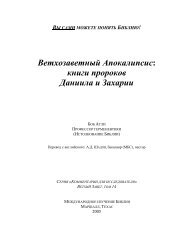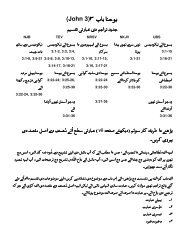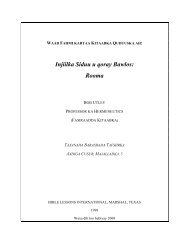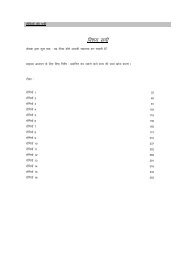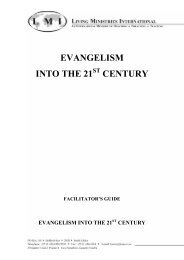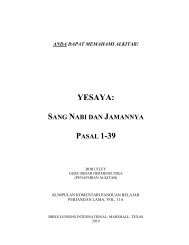Jesaja 1-39 - Free Bible Commentary
Jesaja 1-39 - Free Bible Commentary
Jesaja 1-39 - Free Bible Commentary
Create successful ePaper yourself
Turn your PDF publications into a flip-book with our unique Google optimized e-Paper software.
“The illumination comes to the minds of God’s people – not just to the spiritual elite. There is no guru class<br />
in biblical Christianity, no illuminati, no people through whom all proper interpretation must come. And so, while<br />
the Holy Spirit gives special gifts of wisdom, knowledge and spiritual discernment, He does not assign these<br />
gifted Christians to be the only authoritative interpreters of His Word. It is up to each of His people to learn, to<br />
judge and to discern by reference to the <strong>Bible</strong> which stands as the authority even to those to whom God has given<br />
special abilities. To summarize, the assumption I am making throughout the entire book is that the <strong>Bible</strong> is God’s<br />
true revelation to all humanity, that it is our ultimate authority on all matters about which it peaks, that it is not a<br />
total mystery but can be adequately understood by ordinary people in every culture.”<br />
B. oor Kierkegaard, uit Bernard Ramm, Protestant Biblical Interpretation, bl. 75:<br />
“According to Kierkegaard the grammatical, lexical, and historical study of the <strong>Bible</strong> was necessary but<br />
preliminary to the true reading of the <strong>Bible</strong>. To read the <strong>Bible</strong> as God’s word one must read it with his heart in his<br />
mouth, on tip-toe, with eager expectancy, in conversation with God. To read the <strong>Bible</strong> thoughtlessly or carelessly<br />
or academically or professionally is not to read the <strong>Bible</strong> as God’s Word. As one reads it as a love letter is read,<br />
then one reads it as the Word of God.”<br />
C. H.H. Rowley in The Relevance of the <strong>Bible</strong>, bl. 19:<br />
“No merely intellectual understanding of the <strong>Bible</strong>, however complete, can possess all its treasures. It does<br />
not despise such understanding of the spiritual treasures of this book if it is to be complete. And for that spiritual<br />
understanding something more than intellectual alertness is necessary. Spiritual things are spiritually discerned,<br />
and the <strong>Bible</strong> student needs an attitude of spiritual receptivity, an eagerness to find God that he may yield himself<br />
to Him, if he is to pass beyond his scientific study unto the richer inheritance of this greatest of all books.”<br />
VI. Hierdie Kommentaar se Metode<br />
Die Studiegids-Kommentaar is ontwerp om jou te help met die interpretasie-prosedure op die volgende maniere:<br />
1. ‘n Kort historiese uiteensetting as bekendstelling van elke boek. Gaan hierdie inligting na nadat jy leessiklus #3<br />
voltooi het.<br />
2. Die verskillende dele van die literêre eenheid word in konteks geplaas aan die begin van elke hoofstuk om jou te<br />
wys hoe dit gestruktureer is.<br />
3. Aan die begin van elke hoofstuk of groot literêre eenheid word die paragraafindeling saam met hulle beskrywende<br />
onderskrifte verskaf. Dit word uit die volgende moderne vertalings geneem:<br />
a. The United <strong>Bible</strong> Society Greek text, vierde uitgawe gewysig (UBS 4 )<br />
b. The New American Standard <strong>Bible</strong>, 1995 weergawe (NASB)<br />
c. The New King James Version (NKJV)<br />
d. The New Revised Standard Version (NRSV)<br />
e. Today’s English Version (TEV)<br />
f. The Jerusalem <strong>Bible</strong> (JB)<br />
g. Die Ou Afrikaanse Vertaling (OAV)<br />
h. Die Nuwe Afrikaanse Vertaling (NAV)<br />
i. Die Nuwe Lewende Vertaling (CUM-NLV)<br />
j. Die Multivertaling Bybel (CUM-MVB)<br />
Paragrafering is nie geïnspireer nie. Dit moet uit die konteks afgelei word. Deur ‘n vergelyking van ‘n aantal<br />
moderne vertalings vanuit verskillende vertaling-denkskole en teologiese perspektiewe, word dit vir ons moontlik<br />
om die veronderstelde struktuur van die skrywer se gedagtes te analiseer. Elke paragraaf het een hoofwaarheid.<br />
Dit word gewoonlik die “tema-sin” of “sentrale idee van die teks” genoem. Hierdie eenheidsvormende gedagte is<br />
die sleutel tot gepaste historiese, grammatiese interpretasie. Ons moet nooit interpreteer, preek of onderrig oor<br />
minder as ‘n paragraaf nie! Onthou ook dat elke paragraaf verwant is aan die omliggende paragrawe. Dit is<br />
hoekom ‘n paragraaf-vlak raamwerk van die hele boek so belangrik is. Dit moet vir ons moontlik wees om die<br />
logiese vloei van die onderwerp te volg volgens die bedoeling van die oorspronklike outeur.<br />
4. Bob se notas volg ‘n vers-vir-vers benadering tot interpretasie. Dit dwing ons om die oorspronklike outeur se<br />
gedagtegang te volg. Die notas bied inligting oor ‘n verskeidenheid aspekte:<br />
1. literêre konteks<br />
2. historiese, kulturele insigte<br />
3. grammatiese inligting<br />
4. woord-ontleding<br />
5. relevante parallelismes<br />
5. Soms word die gedrukte teks in die kommentaar uit The New American Standard Version (1995 weergawe)<br />
afgewissel met die vertalings van verskeie ander moderne weergawes:<br />
a. The New King James Version (NKJV) is ‘n woord-vir-woord letterlike vertaling gebaseer op die Griekse<br />
manuskrip-tradisie bekend as die Textus Receptus.<br />
b. The New Revised Standard Version (NRSV) is ‘n gewysigde woord-vir-woord vertaling van die National Council<br />
of Churches se Revised Standard Version.<br />
c. The Today’s English Version (TEV) is ‘n dinamiese eweknie-vertaling wat deur die United <strong>Bible</strong> Society<br />
gepubliseer is.<br />
d. The Jerusalem <strong>Bible</strong> (JB) is nog ‘n dinamiese eweknie-vertaling gebaseer op ‘n Franse Katolieke vertaling.<br />
xiv



